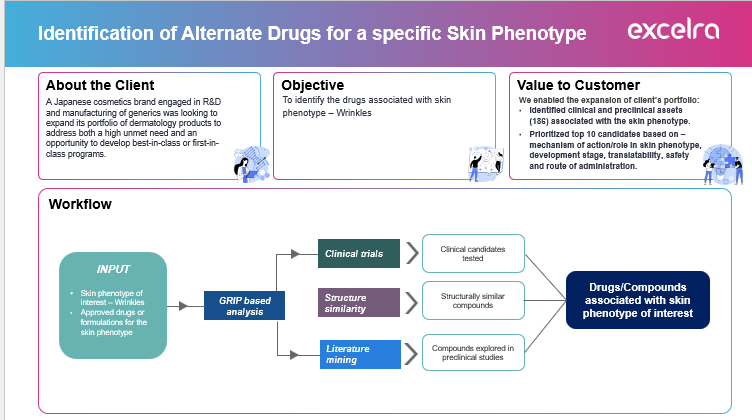Overview
A prominent Japanese pharmaceutical company sought to accelerate dermatology innovation by leveraging AI-driven drug repositioning and bioinformatics in drug discovery. The focus was on identifying existing drugs with potential efficacy for aesthetic skin concerns, specifically targeting wrinkles, to streamline the drug discovery process while minimizing cost and risk. This approach leveraged computational biology services to extract and analyze high-quality data for precise drug prioritization.

Our client
A research-focused pharmaceutical company in Japan, specializing in generic formulations and dermatological therapeutics, strategically leveraging emerging science to expand therapeutic indications. The client also actively integrated scientific application development for drug discovery into their R&D operations to enhance pipeline efficiency.

Client’s challenge
The client aimed to diversify and strengthen its dermatology pipeline by identifying drugs with repurposing potential. Traditional drug discovery approaches were time-consuming and costly, and the client needed a data-driven strategy to uncover repositioning opportunities for wrinkle-associated skin phenotypes efficiently. Leveraging bioinformatics in drug discovery was essential to overcome fragmented literature and identify promising candidates.

Client’s goals
- Accelerate dermatology drug discovery with a focus on skin aging and wrinkle treatment.
- Minimize early-stage R&D costs and reduce time to preclinical prioritization.
- Utilize drug repositioning strategies to expand the dermatology pipeline rapidly and safely.
Our approach
Excelra deployed a computational drug repositioning strategy powered by advanced AI and bioinformatics in drug discovery to identify novel links between phenotype and pharmacology. The approach included:
AI-Enabled Phenotype Mapping
Used natural language processing (NLP) and machine learning to extract and correlate scientific literature, identifying drugs associated with wrinkle-related skin phenotypes.
Pathway and Mechanism Analysis
Mapped drugs to biological pathways relevant to skin aging and elasticity, focusing on targets with dermatological relevance.
Translational Prioritization
Assessed 186 drug candidates based on their mechanism of action, safety profile, clinical development stage, and translatability to dermatological use. This step was supported by data curation and semantic services to ensure high-quality, structured datasets for analysis.

Our solution
Excelra’s AI-driven drug repositioning delivered a focused portfolio of 10 high-potential drug candidates selected from an initial pool of 186. This shortlist was curated based on rigorous phenotype-to-pharmacology mapping, mechanism-of-action alignment with skin aging pathways, and strong safety and translational profiles.
Key outcomes included:
Strategic Pipeline Expansion
Augmented the dermatology portfolio with validated repositioning opportunities targeting wrinkle-associated skin phenotypes.
AI-Centric Innovation
Applied machine learning and NLP to bridge literature gaps and uncover non-obvious drug-phenotype relationships, overcoming traditional limitations of fragmented aging research.
R&D Acceleration
Enabled rapid preclinical prioritization and streamlined downstream development planning in the drug discovery process.

Conclusion
AI-driven drug repositioning and bioinformatics in drug discovery offer a robust solution to dermatology’s most pressing challenges—the complex biology of skin aging, limited validated therapeutic targets, and high cost and risk of traditional drug discovery. Excelra’s approach enabled a 94% reduction in the candidate pool, a 50% acceleration in preclinical decision-making, and an estimated 30% reduction in early-stage R&D costs. This data-driven methodology significantly increased the likelihood of clinical success, empowering the client to expand its dermatology pipeline and gain a competitive edge in aesthetic therapeutics. For similar strategies in structured and AI-ready datasets, see our structured and analysis-ready data for AI/ML-based drug discovery case study.

